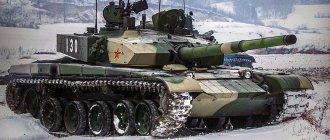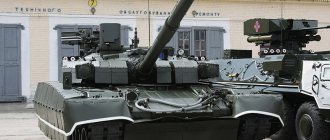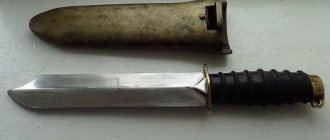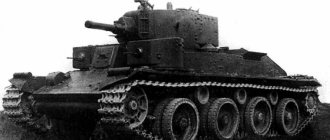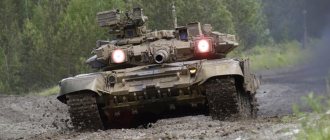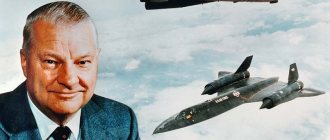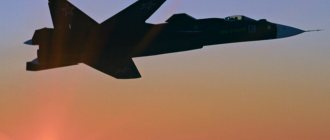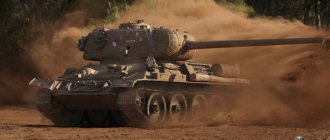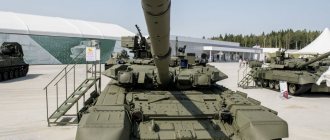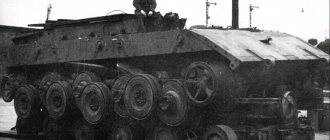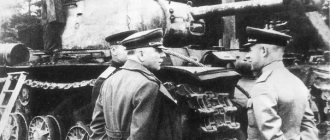This term has other meanings, see Black Eagle (meanings).
| Black Eagle | |
| Object 640 | |
| Classification | main tank |
| Combat weight, t | 48 |
| Layout diagram | alternative |
| Crew, people | 3 |
| Story | |
| Developer | JSC "KBTM" |
| Manufacturer | |
| Number of issued, pcs. | 1 |
| Dimensions | |
| Case length, mm | 7970 |
| Width, mm | 3095 |
| Height, mm | 1793 |
| Ground clearance, mm | 500 |
| Booking | |
| Armor type | modular |
| Active protection | "Drozd-2" |
| Dynamic protection | DZ "Cactus" |
| Armament | |
| Caliber and brand of gun | 125 mm |
| Gun type | smoothbore gun |
| Gun ammunition | 32 (in AZ) |
| Machine guns | 1 × 12.7 mm Cord[1], 1 × 7.62 mm PKT |
| Other weapons | smoke grenade launchers |
| Mobility | |
| engine's type | gas turbine engine |
| Engine power, l. With. | 1500 |
| Highway speed, km/h | about 80 |
| Cruising range on the highway, km | more than 500 (without external tanks) |
| Specific power, l. s./t | 31,25 |
| Suspension type | torsion bar |
| Specific ground pressure, kg/cm² | 0.87-0.9 (With extensions 0.80-0.81) |
| Wall to be overcome, m | 0,8 |
| Ditch to be overcome, m | 2,8 |
| Fordability, m | 5 (with OPVT) |
"Black Eagle"
(“Object 640”) is a Russian project of a promising main tank, developed in the 1990s by the Omsk Transport Engineering Design Bureau.
The prototype was first demonstrated in 1997[2] and was a modified chassis of the main T-80U tank with a new design turret installed on it. Subsequently, a prototype was created with a turret mounted on a seven-roller chassis. Not mass produced. During demonstrations of prototype tanks at exhibitions, the tank's turret was always covered with a dense camouflage net[3][4].
Design[edit | edit code]
The main design
of the tank chassis is a modified T-80U chassis. The hull was lengthened, which made it possible to significantly strengthen the upper frontal part and eliminate the weakened area in the area of the driver's periscopes. The tank hull is divided into three sealed compartments, isolated from each other by vertical armored sheets, which are installed along the longitudinal axis. Fuel tanks are located in the side compartments. In the central compartment there is a control compartment connected to the fighting compartment. Seats for crew members are located in the tank hull below the turret level. Access to them is through the commander's and gunner's hatches in the turret body and the driver's hatch in the tank's body. The crew seats are equipped with adjustable seats that have two positions: traveling and combat. When the seats are moved to the firing position, the crew is below the level of the turret ring. In the traveling position, the gunner and tank commander are located in the hull and turret[5].
The design of the tower implied an increase in the thickness of the armor with a parallel increase in the angle of inclination of the armor plates, which significantly increased the protection of the crew. The weight of the turret increased by 20-25 percent compared to the T-80[6].
On the side of the fuel compartments, the vertical armored sheets of the hull are covered with plates of anti-radiation material, and on the side of the control compartment and fighting compartment - with plates of anti-fragmentation material. The ammunition is located in an automatic loader installed in the turret niche and made in the form of a removable armored module with ejective armor panels that are triggered in the event of detonation. The welded tower is of a fundamentally new type. It is made in the form of two symmetrically spaced armored compartments, rigidly attached to a common base. The compartments are formed by spaced apart and coaxially located internal and external side walls, made along the front contour in the sector from the embrasure to the transverse axis of the tower in the form of truncated pyramids.
The project included arming the tank with a 125 mm cannon, a coaxial 7.62 mm machine gun and a remote anti-aircraft gun with a 12.7 mm Kord machine gun[1]. However, the design of the tank included the possibility of a larger caliber gun - up to 152 mm.
With a combat weight of 48 tons, the tank was supposed to be equipped with a new gas turbine engine with a power of more than 1,500 hp. With. Thus, the specific power of the tank exceeded 30 hp. s./t and, as a consequence of this, the dynamic characteristics of the “Object 640” should have significantly exceeded the characteristics of Western third-generation tanks with a specific power of 20 - 25 hp. s./t[7]
Three squares
IMMEDIATELY after the scout’s path, having taken off his weapons, equipment and shoes, the candidate went out to the “squares”. Three squares measuring four by four meters are platforms for hand-to-hand combat. The conditions were as follows: the dealer must spend three three-minute duels with three opponents without rest, moving from square to square. You are in the forests and fields for 36 hours, and the examiners are fresh, merciless!
I missed the first blow before I could close. I couldn’t feel my arms or legs, they didn’t obey me like strangers, I was feeling tired. I tried to dodge and missed another blow. A fog began to appear before my eyes, and away I went... They hit me in the head, on the legs, on the body, but I had one word in my brain - “stand.” And he stood. I could have fallen and thereby stolen a few seconds, but I stood. Moving from square to square, I felt my legs, arms, nose, lips, cheekbones go numb, but I still remained on my feet. I no longer needed anything except one thing: to stand, not to fall.
They were awarded the “Black Eagle” badge on the brigade parade ground. Having received my sign, I pressed it to my broken lips, and the thought flashed through my head: “How similar the taste of copper and blood is.”
Oleg GREBENNIKOV, lieutenant colonel, commander of the communications battalion of the 38th separate mobile brigade
Project prospects[edit | edit code]
According to representatives of the Ministry of Defense of the Russian Federation (Ministry of Defense of Russia), mass production of the promising Object 640 tank is not planned. Nevertheless, the solutions developed on this model will serve as a significant foundation for the modernization of existing tanks[8]. For many years, reports have repeatedly appeared in the media about the progress of development and testing of the Black Eagle tank, but no details about the timing and plans for launching mass production were reported[9][3][10]. However, on September 12, 2009, the acting head of the military-scientific committee of armored weapons and vehicles of the Russian Ministry of Defense, Colonel Vladimir Voitov, stated that the Black Eagle tank, called a fourth or even fifth generation armored vehicle and also known as Object 640
", does not exist[11][12][4].
On April 28, 2011, the former first deputy of the Main Armored Directorate of the Russian Ministry of Defense, Major General Yuri Kovalenko, announced that the developments of the Black Eagle would be used in the new main Armata tank[13][14].
Online game “World of Tanks” and its impact on society
Thanks to the computer game World of Tanks, modern youth have become interested in armored vehicles, both from the Second World War and modern systems. Just ten years ago, few young people would have been able to name which tanks took part in this or that military campaign, which models were produced by the countries participating in that war, not to mention their technical characteristics. However, today even elementary school students can easily navigate these issues; they discuss what types of ammunition should be used in a given situation, develop a combat strategy for various types of military equipment in certain geographical conditions, taking into account the terrain, and so on. Of course, the World of Tanks game is limited to models of armored vehicles of the Second World War and the post-war period. There you will not find combat systems that are in service in modern armies of the world, but the process, as they say, cannot be stopped: if young people are interested in something, then it is serious and for a long time. And increasingly, inquisitive minds are turning to the World Wide Web in order to get acquainted with the latest tank building products, find out their characteristics, etc. We will talk about one of these models, which is still in service, in this article.
Notes[edit | edit code]
- ↑ 12
Koshchavtsev A. “Black Eagle” // Tankmaster. - 1999. - No. 3 - Exhibits of VTTV-Omsk'97 - Omsk Arms Exhibition (unspecified)
(inaccessible link). Retrieved October 14, 2009. Archived September 18, 2020. - ↑ 12
Russia declassified the Black Eagle tank - ↑ 12
“Black Eagle” flew away, Nezavisimaya Gazeta, September 14, 2009 - “Black Eagle” (“Object 640”), Russian promising new generation battle tank Archival copy dated November 26, 2010 on the Wayback Machine, arms-expo.ru
- YouTube (undefined)
. www.youtube.com. Retrieved January 15, 2020. - Main battle tank "Black Eagle" (unspecified)
(inaccessible link). Retrieved September 13, 2009. Archived April 11, 2010. - Object 640 “Black Eagle”, btvt.narod.ru
- The Russian army will receive a new missile and tank
- The Russian Black Eagle tank received a patent from the Eurasian Patent Office
- The Russian Ministry of Defense has denied the existence of the unique Black Eagle tank
- “Military Council” with Vladimir Voitov
- The new Armada tank may appear in the Russian army in 2015, RIA Novosti
- Russia will adopt the new Armada tank, Lenta.ru
Combat use
The UR-77 mine clearing installation has a rich (for this class of equipment) history of combat use in three military conflicts of the past decades. The first episode of the participation of “Snake Gorynych” in a hot spot was the second Chechen war. The installation was used by the Russian army during operations in Chechnya.
The second episode was the armed conflict on the territory of Donbass during the attack on the airport. Recently, the UR-77 installation has been actively used by Russian troops in Syria. As we know, many Syrian cities were mined by militants, and even at the present moment only part of the minefields around them have been cleared.
Design
The general view of the missile launcher is a one-piece floating welded body with two launchers placed on top of it and the equipment necessary for launching. The crew consists of two people - a driver and a commander-operator.
The power plant is YaMZ-238N, which is an eight-cylinder V-shaped 300-horsepower diesel engine, fuel consumption is 140 liters per 100 km. Chassis: torsion bar suspension. The machine moves on water by rotating the tracks. Dimensions of the UR-77 combat vehicle:
| Length, mm | 7860 |
| Width, mm | 2850 |
| Height, mm | 2545 |
| Base, mm | 3700 |
| Ground clearance, mm | 400 |
The only means of mine clearance that the installation has are UR-77 “Meteorite” rocket charges of different brands – UZ-67, UZP-77 and ZRSh.
This ammunition consists of a jet engine, behind which runs a long hose filled with an explosive substance (TNT, PVV-7 or TGAF-25). The length of the hose varies depending on the model used. The installation accommodates two such ammunition, and reloading is completed in 30-40 minutes.
Performance characteristics and analogues
Only two countries in the world have truly competitive cars.
The only comparable model of such equipment in terms of characteristics is the American M58 “MICLIC” missile launcher, however, a significant drawback compared to the Russian model is that the installation is placed on a towed trailer and is not capable of moving independently.
| UR-77 | M58 | |
| Passage length, m | 80-100 | 100 |
| Explosive mass. kg | 41-725 | 794 |
| Passage width, m | 6 | 6-14 |
As we can see from the comparison table, the UR-77 is inferior to its Western competitor only in terms of aisle width. However, this parameter depends solely on the type of charge, the improvement of which is only a matter of time for designers.
Mobility
The tank was supposedly equipped with a new engine with a power of more than 1650 hp. This power is developed by a promising X-shaped diesel engine. A vehicle equipped with such an engine and transmission must have high driving characteristics and a smooth ride. At the same time, the noise characteristics of the X-shaped engine are much better than those of all engines that were previously equipped with domestic tanks. The crankshaft in the Object 195 is probably located along the axis of the car. This is due to the layout of the engine and facilitates docking with a hydromechanical transmission.
Perhaps the engine was going to use the A-85-3 (12N360) diesel engine developed at ChTZ - four-stroke, X-shaped, 12-cylinder, gas turbine supercharged, liquid cooled with intermediate air cooling. Engine capacity is almost 35 liters, power is 1650 hp. (when boosted to 2200 hp). Compared to previous ChTZ engines, it is distinguished by significantly smaller dimensions: length - 81.3 cm, width - 130 cm, height - 82 cm. Engine weight - 1550 kg, torque reserve - 30%, specific fuel consumption - 160 g/l .s.h. The engine is a completely new design and has great potential for increasing power with a slight increase in overall dimensions and weight.
Other projects
According to information from Western sources in the early 1980s, there was the following layout option for a promising tank. The height of the tank is about 2 m. The gun is connected to a rotating fighting compartment and an automatic carousel-type loader. Two crew members are seated in horizontal seats. Observation of the battlefield is carried out using periscopes and optical instruments. The tank commander has a laser rangefinder and an infrared night vision device.
The tank is equipped with a laser device to destroy the optics of sights and surveillance devices of enemy tanks and anti-tank systems (LASAR). It surveys the area with a low-power laser beam and records reflections from the lenses of enemy optical instruments. Having detected a reflection, it sends a high-power laser pulse there, blinding the observer or an electronic surveillance device, this means is now actually used on the Chinese Type 98 tank.
The use of such weapons is partially prohibited by the UN in accordance with Protocol IV to the Convention on Certain Conventional Weapons of October 13, 1995.
The main armament of the tank is a 152-mm 2A83 smoothbore gun with the ability to launch a guided missile through the barrel.
In the vision of Omsk designers, the tank of the future should remain a rocket-gun tank, weighing up to 50 tons, with a large-caliber cannon removed from the fighting compartment, and artillery shells that not only have increased power, but also can be adjusted along the trajectory (the “fire and forget” principle). struck"). It must have a seven-wheel chassis with a front-mounted engine-power unit and hydropneumatic or adjustable suspension. Gas turbine engine power is 1800 hp. (symbiosis with a diesel engine is not excluded) should allow the tank to reach a maximum speed of at least 95 km/h, with an average speed of up to 60 km/h on dirt roads. Accommodation for a crew of up to 2 people is in an isolated control room in the most protected middle part of the hull; automated fire control system, a set of life support systems, ergonomic chairs. The block-modular design of a promising tank will allow, by replacing functional modules, to create a family of unified vehicles: a tank support combat vehicle, a self-propelled artillery mount, a support vehicle with an anti-tank missile system, a reconnaissance and control vehicle, and a robotic combat vehicle.
Fire control system
Information about the target was to be received via optical, thermal imaging and infrared channels, and it was supposed to include a laser range finder and radar station. It should be noted that the new layout placed very stringent requirements on the control system, since the crew was deprived of the opportunity to use traditional optical instruments. Western designs for tanks with an uninhabited turret provide that information about the situation on the battlefield will be displayed on screens that will create for the crew the effect of seeing through the armor in any direction.
It was also planned to equip the “Object 195” with a “friend or foe” complex, which would allow more dynamic action in the complex and rapidly changing conditions of the modern battlefield.
Penalty ambush
The ROLE of the liaison was performed by... the commander of the guard brigade, Lieutenant Colonel Valery Sakhashchik. He didn’t say, but cut down every word: “You didn’t complete the second task! According to the test conditions, the group must be removed! But the leadership headquarters is giving you a chance... By sixteen o’clock, organize an ambush on a section of the highway.” The brigade commander's pencil marked a point on the map.
The conditions are tough: to be on time by the specified time, you need to go without delay, and the guys are dead tired. It was necessary to consult with the group. I went to the guys, knowing in advance that they would not refuse to take the chance to continue the test, and I was not mistaken. Three minutes to rewind the foot wraps, adjust the equipment - and off you go! The hot earth radiates heat, hot sweat eats at the eyes. We're in a hurry. We drink as we go, one sip at a time, dividing the last flask among four. Yes, there are already four of us. Army magazine correspondent Pavel Legky went with us to the penalty ambush. Thank you, Pasha, thanks to you and our conversation “for life”, that road really became a little easier!
Despite the fact that they had to get lost a little, the group even got to the ambush site a little earlier than the planned time. And here I cannot deny myself the pleasure of quoting a direct participant in the events, Pavel Legky: “... A fragment of an action movie from the life of local saboteurs, demonstrated ten minutes later by the candidates for the “black eagles”, with a creak, but it passed. Getting into the UAZ, the brigade commander said:
“Remove the log from the road and move on...”
Raid
FURTHER, the Brest training ground awaited us, marked on the map as the Sahara tract. Our last object there is the “RAV warehouse” (an abandoned tower at a shooting range). The area lives up to its name. Along the sand dunes, under the scorching sun, we continue our almost 24-hour marathon. Where does the strength come from? The guys are generally great. Ivgas Borisevich refuses all offers to replace him in carrying the radio station; Andrei Parakhnevich has chafed his legs, but keeps up.
We go out to the object before dark. Of course, they are waiting for us. The “warehouse” is guarded; there are “signals” on guy wires along the perimeter. We lay down, studying the approaches and the security system. Suddenly shooting, explosions! Some group launched an assault from the direction of the shooting range. We decide, without allowing the guards to come to their senses, to also attack, but from the direction of the forest. Quietly we approach the object. We were noticed, but too late. Throwing a smoke bomb at the window, firing machine guns at the guards, who were maddened by such impudence! All! That's all for today! Having completed the last task, we get the opportunity to rest until the morning. We settled in for the night right there - near the destroyed “warehouse”. There was no strength left to equip any kind of shelter, they covered themselves with raincoats and collapsed, as they say, where they stood. Not paying attention to the ubiquitous mosquitoes or the heavy rain in the middle of the night. Sleep, just sleep!
...In the morning, during the general formation, the groups were “disbanded.” From that moment on, each candidate worked for personal merit. After wishing each other good luck, we went to the firing line. The shooting started at nine in the morning. They had to shoot from all small arms in service with the brigade: AKS-74, AKM with PSB, PKM, RPK-74, PM, SVD, grenade launchers - RPG-7 and AGS-17. At the end - throwing an RGD-5 hand grenade. After shooting, without a break, the candidates went to the start of a 6-kilometer forced march in full gear. The time was not recorded, but no one walked - a matter of honor. The main thing is not to allow even the thought of stopping or getting off. If you stop, that's it! There will be no force that will force you to continue running. And they ran. On "automatic". The forced march did not have a finish line as such: on the move, without a break, the candidates entered the scout’s path. “Trail” is a chain of obstacles. The first obstacle is the “coast”: a blockage of driftwood and fragments of reinforced concrete. Behind the “coast” there is a two-meter ditch. Behind the ditch is the “city dump” - a mountain of scrap metal abundantly smeared with burning napalm. Behind the landfill is a “fiery font”: a body of water with burning fuel on the surface. Then it was necessary to overcome a “swamp area”, a “forest blockage”, climb about five meters along a reinforced concrete pipe under a section of road, destroy a “truck” by blowing up, and undergo a “break-in with armored vehicles”. After the run-in - again a “swampy area”, a “cliff”, a “wall”, again a “blockage” and, finally, a “moustrap”: 50 meters of barbed wire and a minimum wage overhead. I don’t remember how it all went! I only remember that I was running, they shot at me, I responded, I climbed through something, fell somewhere, but overall I don’t remember!
History of origin
During the first two world wars, the main means of mine clearance were specially trained people - sappers.
Despite the greatest prevalence, this approach has a number of fatal drawbacks:
- Training and preparation of a fighter in this specialty is a slow and complex process, since this profession has a huge number of subtleties.
- The vast majority of combat missions of these fighters take place on enemy territory, which several times increases the likelihood of their destruction or capture.
- The design features of some mine models do not allow mine detectors to detect themselves (cases made of wood or plastic, to which the mine detector will not respond).
- Clearing mines manually is time-consuming and labor-intensive, which can be frustrating if you need to attack quickly.
But during the First World War, a British sapper engineer developed a simple and at the same time effective solution. It received the simple name “Bangalore Torpedo” - a long pipe filled with explosives, which, when deepened into the soil in a mined area, allows you to detonate (and accordingly clear) several mines at once.
This fairly fast method of mine clearance was also used during WWII in various variations. However, there is an obvious drawback. It was possible to increase the length of such a structure as much as desired, but, nevertheless, it was problematic to assemble a hundred-meter pipe in combat conditions and deliver it to a minefield. The designers made an elegant decision - to make such a charge self-propelled.
Unsuccessful experience with the UR-3R showed that such equipment should be self-propelled, and in 1967 the UR-67 (Demining Installation of the 67th year) entered the Soviet Forces. The vehicle was built on the basis of the BTR-50PK with an installed launcher for the UZ-67 device, which was an 83-meter hose filled with TNT. It was fired at a distance of 200-350 meters and exploded, opening the way for the advancing troops. Because of the spectacle of the launch of the charge itself, the installation was awarded the nickname “Snake Gorynych.”
In 1978, the UR-67 (by that time outdated and having insufficient range) was replaced by the UR-77 “Meteorite” mine clearing vehicle. The installation, unlike its predecessor, is based on the 2S1 “Gvozdika”. “Meteor” or in other words “Serpent Gorynych” (as it became common to call all UR) had a number of advantages, due to which it completely replaced the UR-67 in the army, which has now been withdrawn from service.
Down and Out trouble started
MAY 15. Six groups of candidates of three to four people gathered in the brigade meeting room to complete the task. Within a day and a half, we must walk about a hundred (!) kilometers, complete five tasks, fire exercises with ten types of weapons, complete a 6-kilometer forced march, overcome a scout’s path and survive three rounds of hand-to-hand combat. The test is led by the Chief of Staff of the Guard Brigade, Lieutenant Colonel Skorina. Everything is short and clear. Within half an hour after receiving the tasks, we are loading into the Urals... The brigade commander seeing us off said: “Let's go!” And he waved his hand...
Outside the city, I take out a map and try to trace the route. Shchebrinsky forest, Zaki, Volki village. From time to time, the Ural makes short stops to disembark groups. My third group (me, guard sergeant Ivgas Borisevich, guard private Andrei Parakhnevich) dismounts as the last one. I look at my watch: according to the test plan, we are already 40 minutes into the task. I take my bearings on the area: the “start” point we got was also a mass grave site. The head of the machine sympathizes and, as if by chance, says:
— During the first test, in December, the group that was dropped off here did not reach the finish line.
Thank you for your kind words, dear man... Once again we adjust the equipment, report on the radio about the start of movement and forward: “Strictly southwest about fifteen kilometers.” It’s already twilight in the forest and there are myriads of mosquitoes. We try to walk quietly, but quickly - before the sun sets, we need to go as far as possible, and the midges are not that bad. Already in the dark, having passed through the forest, we came to a canal crossing the field. The width and depth, judging by the map, are decent. There are no available means of crossing - it’s a bare field, and they didn’t provide their own (mistake!). We decided not to go into the water, not to risk the radio station, but to make a detour to the nearest dam. As night fell, it became noticeably cooler, the mosquitoes disappeared, but the pace of movement decreased. You can't walk quickly through the forest in the dark.
We reached the search area for the object an hour late, and also had to “cover” a three-by-three-kilometer square of night forest! We were lucky; after half an hour of searching, we literally stumbled upon the KShM of the head of the tests of the guard, Lieutenant Colonel Skorina.
Surprise from topographers
SO, we have the first test, but we are already an hour and a half behind schedule, and we have to be at the second facility before nine in the morning. For two hours we walked along abandoned clearings in the dark, almost by touch. It takes a lot of time to clarify the route; we walk, stumbling in the dark, constantly checking the map. The numbers of forest squares on the found quarter posts differ from the marks on the map... but the main surprise from the topographers lay ahead.
Morning has come, the tops of the trees are gilded with dawn, the silence of the night is replaced by a bird concert, but we have no time for embellishment. The squeak of a mosquito tears at your nerves, bloodsuckers crawl into your nostrils, ears, eyes, cling to your arms, neck, and crawl under your “hebe.” The clearing along which we are moving gradually goes under water. At first we walked in ankle-deep water, then knee-deep, then waist-deep, chest-deep. Return to the starting point, go around? We will lose time, which we have almost no time left, and the object - the bridge - here it is! Judging by the map, only a few kilometers! Having raised our weapons and radio station above our heads, we make our way further. And the further you go, the worse it gets: it gets deeper and your legs begin to get stuck. A swamp?.. And there’s a forest on the map! In an hour we covered three hundred meters! The time to complete the second task has expired, but we continue to move towards the goal. Or rather, swim. In the middle of the swamp, either a mound or a hill rises like an island with a lone pine tree on top. We row towards it and, having got out of the water, fall exhausted onto the sand. We lie there for about five minutes, unable to talk or move, but we have to. The group missed two sessions of contacting the CP. I can imagine what's going on there now! Having gathered my strength, I tune the radio station to the frequency. No connection! The R-159 whip antenna does not reach the control panel, and we did not take the “travelling wave antenna” (second mistake!). We decide to take a 15-minute break, have a snack and move on. There is no appetite, the stew does not fit into the throat, we eat to maintain strength and alleviate RD. It’s a strange thing: after spending several hours in the water, we only want to drink. Having got out of the swamp, we find ourselves in the “jungle” - a solid wall of bushes, trees, giant ferns. The air is humid and stuffy. There are no landmarks, we are moving in azimuth. The one walking in front has to literally cut through the thickets, so we replace each other. 12.00... Finally got in touch. Skaryna ordered to stop performing the second task and go to the meeting square with the messenger.
Concept
As many experts note, today there is no place for tank battles, which distinguished the Second World War. Modern military operations exclude confrontation of large armed forces; they are based on a local, targeted principle, requiring, accordingly, a small amount of equipment and manpower. For such combat tactics, the Black Eagle tank is the optimal vehicle, characterized by increased power and mobility. It is suitable for rapid deployment and transport, including air travel.
